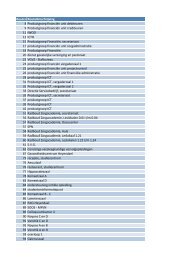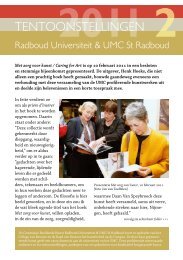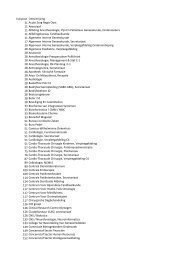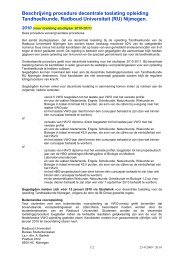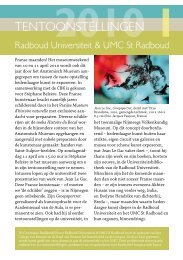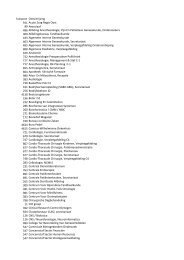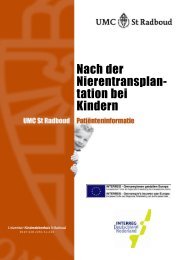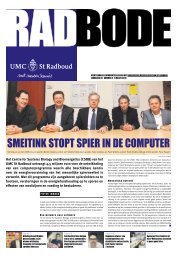Neuralgic Amyotrophy: idiopathic and hereditary ... - UMC St Radboud
Neuralgic Amyotrophy: idiopathic and hereditary ... - UMC St Radboud
Neuralgic Amyotrophy: idiopathic and hereditary ... - UMC St Radboud
Create successful ePaper yourself
Turn your PDF publications into a flip-book with our unique Google optimized e-Paper software.
Information for the family doctor <strong>and</strong> physiotherapist<br />
This condition is now generally called neuralgic amyotrophy, but is also known<br />
under the somewhat older name of ‘Parsonage-Turner syndrome’ <strong>and</strong> ‘plexus<br />
neuritis’. There is an <strong>idiopathic</strong> <strong>and</strong> a (rare) autosomal dominant genetic form of<br />
the condition. The main characteristic of this condition is an acute beginning, starting<br />
with extremely severe pain in the neck, shoulder <strong>and</strong>/or arm. As a pain score,<br />
(VAS), patients often give 8 - 10 out of 10. These are often people who have never<br />
before had shoulder or neck complaints. The pain is much more severe than<br />
‘normal’ shoulder or neck complaints <strong>and</strong> hardly reacts at all to painkillers (including<br />
opiates). In the beginning, the pain is present constantly <strong>and</strong> can barely be<br />
influenced by a change of position or anything like that. Characteristically, the arm<br />
is held protectively against the body <strong>and</strong> patients often lie awake for nights on end<br />
because of the pain.<br />
Figure 2. Winged scapula on the right Figure 3. Distal atrophy <strong>and</strong> paresis on the right<br />
32<br />
Generally, after a few hours to days – but sometimes not for a few weeks – a<br />
patchy paralysis of the shoulder blader arch <strong>and</strong> arm muscles develops. There is<br />
also often, strikingly quickly, a considerable atrophy of the affected muscles. The<br />
so-called shoulder blade alata is very characteristic (see figure 2), but this is certainly<br />
not present in every patient. As well as the classical ‘proximal’ form in which<br />
lifting the arm <strong>and</strong> exorotation of the arm <strong>and</strong> the shoulder are affected, there are<br />
also more distal forms in which stretching in the wrists <strong>and</strong> fingers or the small<br />
muscles of the h<strong>and</strong> is often severely curtailed (figure 3).<br />
After thorough questioning, it can turn out that there are often sensory symptoms<br />
in the form of tingling or a slight hypesthesia, but these symptoms are generally<br />
not the most prominent.<br />
The pain generally progresses in three phases: First of all, there is the continuous,<br />
severe neuropathic pain that lasts for several days to weeks, then the pain<br />
disappears in rest, but increases with movement or stretching of the damaged<br />
plexus; finally the patients are then extremely hampered by a persistent muscle<br />
pain through overburdening of the paretic – but also the compensating, healthy<br />
-- muscle groups.<br />
The paresis recovers slowly over a period of months to a few years. This slow<br />
recovery <strong>and</strong> the development of muscle symptoms through ‘surmenage’ or overwork,<br />
often lead to long-term (partial) disability <strong>and</strong> necessitates good supervision<br />
<strong>and</strong> guidance of these patients in rehabilitation <strong>and</strong> employment.<br />
Treatment of neuralgic amyotrophy (NA) in the acute phase<br />
The pathophysiology of an episode or attack is probably a patchy infection inside<br />
the plexus brachialis based on an auto-immune reaction. In order to try to limit or<br />
prevent damage to the nerves as much as possible, we advise, as a painkiller in<br />
the acute phase, a combination of long-acting morphine (for example, MS Contin<br />
2 dd 10-20 mg) with a long-acting NSAID (for example, Diclofenac 2 dd 100 mg<br />
Retard). If there are no contraindications, a short course of oral prednisone can<br />
be considered. We use 60 mg per day for this (i.e. <strong>and</strong> for children: 1 mg/kg) for 7<br />
days, in the following week to be reduced by 10 mg / day to nothing. Prednisone<br />
is no miracle drug; on average, 5 out of 10 NA patients have a favourable reaction,<br />
with a fast decrease of pain, <strong>and</strong>, in 1 or 2 out of 10 people, the recovery is<br />
33



